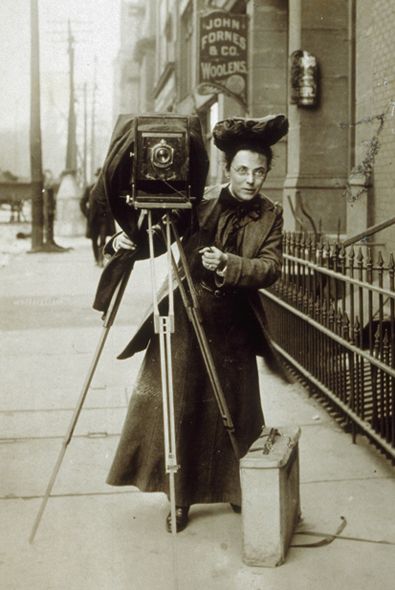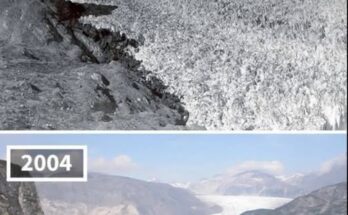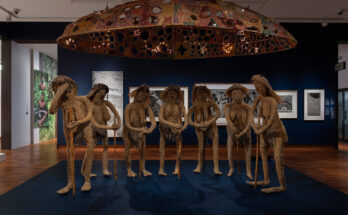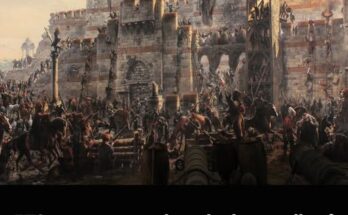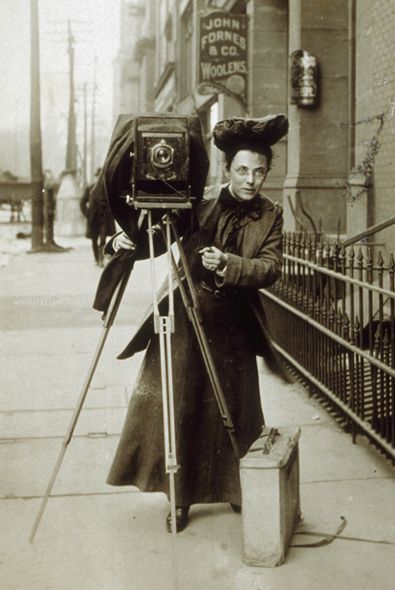
In the sepia-toned photograph you shared, a woman stands poised behind a bulky, tripod-mounted camera on a city sidewalk. Dressed in the elaborate garments of the early 20th century and wearing a formidable expression of concentration, she appears as both an artist and a pioneer. This is Jessie Tarbox Beals, widely regarded as America’s first female photojournalist. Her story is one of bold ambition, professional perseverance, and a refusal to be confined by the gender expectations of her time.
This image is more than a portrait of a photographer; it is a symbol of transformation—of how women began to enter and redefine male-dominated spaces like journalism, technology, and art. Beals was not just photographing history; she was making it.
Early Life and Education
Jessie Tarbox Beals was born Jessie Richmond Tarbox on December 23, 1870, in Hamilton, Ontario, Canada. Her father, a sewing machine manufacturer, abandoned the family when she was young, leaving her mother to raise Jessie and her brother. Despite financial difficulties, Jessie excelled academically and, at the age of 17, earned a teaching certificate, making her the youngest certified teacher in Massachusetts at that time.
Though her formal entry into the working world was as a schoolteacher, her creative inclinations were apparent. She had a deep interest in reading, drawing, and eventually photography—a hobby she took up after receiving a Kodak camera as a premium for selling magazine subscriptions in 1888. That camera would change the trajectory of her life.
From Hobbyist to Professional Photographer
Jessie’s first photographs were taken in Vermont, where she taught school. Despite lacking any formal training in photography, she was soon taking portraits and landscapes with increasing skill. She married Alfred Tennyson Beals in 1897, who supported her artistic pursuits and sometimes assisted her with photographic assignments.
In 1900, she took a significant professional leap. While attending the Pan-American Exposition in Buffalo, New York, she maneuvered her way into photographing the event—even though women were not expected, or often allowed, to act as professional photographers. Jessie obtained press credentials through sheer persistence, becoming the first female staff photographer for a U.S. newspaper when she joined the Buffalo Inquirer and the Courier.
This photograph of her on the sidewalk with her massive camera dates from this era. It symbolizes not only her technical capabilities (working with heavy, glass-plate cameras required strength and precision) but also her courage to work in spaces where few women dared to tread.
Breaking Barriers: The 1904 St. Louis World’s Fair
One of Jessie Tarbox Beals’s most important assignments was the Louisiana Purchase Exposition—commonly known as the St. Louis World’s Fair—in 1904. This event was one of the grandest expositions of the 20th century, attracting visitors and participants from across the globe. Jessie became the first woman hired as an official photographer for the World’s Fair, cementing her status as a groundbreaking photojournalist.
To photograph the fair’s events, Beals had to scale rooftops, climb ladders, and maneuver among large crowds—all while carrying over 50 pounds of camera gear. Her images captured the fair’s architecture, technological exhibits, and cultural pavilions with remarkable clarity and artistry.
Her images stood out for their composition, storytelling, and humanistic focus. Unlike many of her male contemporaries, who often focused on structures or posed portraits, Beals emphasized people and atmosphere. She had an eye for movement, mood, and the spirit of a moment.
A Woman with a Camera in a Man’s World
At the turn of the 20th century, photography was still considered a largely male profession, especially in journalism. Cameras were large, heavy, and required a thorough understanding of chemicals and light. Female photographers were generally relegated to studio work—portrait photography in controlled settings.
Jessie Tarbox Beals shattered those limitations. She carried her camera into city streets, slums, construction sites, and political rallies. She didn’t just take photos—she chased news stories, interviewing subjects, observing public events, and documenting life in motion.
Her work was gritty and real—urban poverty, political movements, and industrial scenes all found their way into her lens. And though she often photographed famous people, from Theodore Roosevelt to Booker T. Washington, she never abandoned her interest in the everyday human experience.
Still, her gender often made her presence in journalistic circles suspect. Editors sometimes doubted her abilities. Other photographers were openly dismissive. But Beals responded with resilience and results. Her photographs began appearing in major national publications like the New York Tribune, Harper’s Weekly, and The Outlook.
Portrait of an Artist: Style and Technique
Jessie Tarbox Beals’s photography blends the realism of documentary work with the elegance of fine art. Her images are often sharply composed but emotionally resonant. She was particularly skilled at capturing light—using it to emphasize facial expressions, textures, or the mood of an environment.
Some hallmarks of her work include:
- Naturalism: Many of her photographs favor natural light and candid moments, aligning with the emerging photojournalistic trend of telling stories visually.
- Empathy: She often portrayed her subjects—especially children, immigrants, and working-class people—with dignity, offering viewers a glimpse into lives they might otherwise ignore.
- Bold Composition: She used strong diagonals, leading lines, and unusual perspectives to make her photos more dynamic.
In a time when women were expected to remain in domestic or decorative roles, Jessie’s photographic voice was confident, clear, and professional.
Later Career and Challenges
Despite her early success, Jessie’s career was not without challenges. She eventually moved to New York City, where she continued working as a freelance photographer, often struggling to make ends meet. In the 1910s and 1920s, she shifted toward more artistic photography and began documenting the lives of Greenwich Village bohemians, intellectuals, and artists.
She also became known for her garden photography, capturing lush urban and suburban scenes that offered a contrast to her earlier, grittier urban photojournalism. These images were published in magazines like American Homes and Gardens and catered to a different, more affluent audience.
However, she never achieved lasting financial success. By the 1930s, the photography world had shifted, and newer technologies and styles were taking hold. Jessie struggled to adapt. She died in 1942, largely forgotten by the mainstream art world.
Legacy
Today, Jessie Tarbox Beals is remembered not just for her pioneering role as a woman in journalism but for the quality and vision of her work. Her photographs are held in major archives including the Library of Congress, the Schlesinger Library at Harvard, and the Smithsonian Institution. Exhibitions have been dedicated to her contributions, and scholars have written about her importance to American visual culture.
Her life continues to inspire women photographers, journalists, and historians. At a time when women were told to stay behind the scenes, Jessie stood boldly behind the lens—on sidewalks, rooftops, and battle lines—capturing life as it happened.
Analysis of the Photograph
This specific photograph, showing Beals with her tripod-mounted camera on a city sidewalk, is layered with symbolism. She’s standing in an urban environment—likely New York—holding a cable release in her hand, preparing to take a picture. Her hat and coat are typical of early 1900s fashion, but the seriousness in her face marks her as someone not to be underestimated.
The equipment she’s using—a large format view camera—is cumbersome and demands technical expertise. Its presence here visually emphasizes her mastery of the tools of her trade, a rebuttal to the era’s belief that women were unsuited for technical or journalistic work.
The image is a portrait of modern womanhood at the dawn of the 20th century: engaged, independent, and unafraid. It reflects the broader cultural shifts happening at the time, including the women’s suffrage movement, labor activism, and the slow dismantling of gender barriers in the workforce.
Conclusion
Jessie Tarbox Beals was a woman ahead of her time—fierce, skilled, and driven by a passion to document the world around her. Through her camera lens, she chronicled a rapidly changing society and opened doors for generations of women who would follow in her footsteps.
The photograph you shared is more than an image; it’s a testament. It reminds us that behind every great historical movement are individuals—often overlooked—who dared to see, speak, and shoot the truth.
